Hello! I am Konstantīns Karpovs - Director of the Aleksandrs Karpovs Art Foundation (AKAF) also known as Aleksandrs Karpovs Mākslas Fonds (AKMF) !
We just applied to the Latvian Foundation for their 2025 grant. If successful, we will now have the added funds needed to publish Aleksandrs art and story in both English and Latvian, as quality art books! We will also be able to support more showings of his art in the U.S. and Latvia. This is critical to today's world where, once again, as Aleksandrs warned us in his art that "Vesture Apsudz" to please learn from your history. We learned very little from the last 80 years. We are now, once again, awakening to the rise of fascism across the U.S.A. and Europe! Aleks still has a story to tell. His art was intended to "shock" the viewer, to awaken them of the pending ecological disaster, potential nuclear holocaust and genocide from fascism!
I will keep you informed of our progress with
---------------------------------------------
I am also the older brother of Aleksanders Karpovs (artist and warrior). All 37 of his original lithographs and etchings are available for you to preview in the art section of the website. [1]
We are now very interested in showing his work at museums in the United States of America, especially holocaust museums, as his art is focused on the evils of fascism and associated genocide. His art is also a personal story of our family holocaust under Joseph Stalin. Our mother Lucija survived by fleeing to America, a story shared by victims of holocaust throughout the world in the past and again today in countries such as Ukraine. His art also exposes the dangers of fascism in the United States, whose resurgence threatens our very democracy today.
Please contact me for further details if you are interested in a collaborative showing of his life’s work in 2025 - 26.
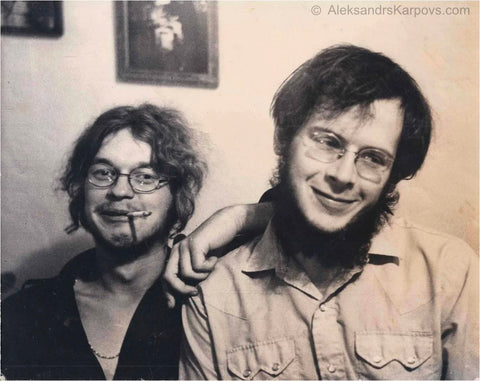
Aleksandrs and Konstantīns (1976) Photo; Michele Karpovs
We have been showing his art in museums across Latvia since 1993. Since then, we have had nine different shows at major museums across Latvia. Typically, the opening for these shows was either on June 14th or March 25th. These dates commemorate the two major events of Soviet genocide of Latvians, in 1941 and 1949, respectively. One of the most prestigious showings of his art opened on June 14, 2014, at the Rothko Museum in Daugavpils, Latvia, where Aleksandrs’ work hung next to artists such as Chagall and Matisse.
Aleksandrs was a social realist who used etching and lithography to show the evils of what he described as the brown fascists in the United States and red fascists in Russia. His work was most influenced by social realists Jacquez Callo, William Hogarth, Francisco Goya, Honor Dormir, Kathy Kollwitz, Otto Dix, John Sloan, George Bellows, Ben Shahn and William Groper.
I'm just going to show you a few of the prints in this blog that highlight some of the key themes of his work, both in the U.S.A. and Latvia. Each of these pieces is also described in the art section of the web site with descriptions in three languages; Latvian, English and Russian.
Aleks' work in both the U.S.A. and Latvia was very prescient, foreshadowing events of today’s world. Aleks was farsighted, seeing history that if ignored poised to repeat itself. In what he described as history accuses. I think it's very important that this art be seen today, especially in the U.S., where once again, populist fascism is on the rise under Trumpism, and Russian genocide under Putin in Ukraine.
Until his death in 1994, my brother courageously exposed Soviet genocide in the Baltics during the “Latvian spring,” when the country was still occupied by some 40,000 Russian troops. Latvia was not yet part of NATO. While still studying for his master’s degree in Riga in 1991, he was twice beaten by police and hospitalized with major concussions.
One month before his death, he sent me a letter jokingly suggesting he may have to leave town, the local Russian colonists in Rēzekne had been beating on his door at night with death threats. This followed the first showing of his artwork exposing Soviet genocide. His letter became serious when he described his wish to be buried with the Latvian flag over his coffin. On March 22nd, Alexanders’ body was found in the corridor next to his room. The circumstances surrounding his death remain a mystery. Days later, when I returned to bury my brother, I found his room had been ransacked. Documents and papers were strewn all over the floor. Hidden under his bed, attached, to the springs, was the plate of his final lithograph “Our Riga.”

“Myusu Riga (Our Riga)” Etching 1993. (Note that the oak tree, a symbol of the Latvian nation, is in foreground with dead leaves facing to the Russian embassy.)
Hidden in his room I also found our grandfather Justyn Volonts’ passport with the deed to his land -- 100 hectares; that had earned him, his wife Stefania, daughter Regina and his brother’s family, a one-way ticket to the Siberian gulags. On June 14, 1941, the Soviets rounded-up and deported his family along with 15,424 Latvians (8,259 men and 7,165 women) in cattle cars. Justyn’s passport has since allowed my brother and I, including my two children and 6-year-old grandson, to obtain dual Latvian and U.S. citizenship!
 “The Black Hole” Deportation from Livani -- 1941 g. June 14. History Accuses (beseeches) III. Lithograph 1993
“The Black Hole” Deportation from Livani -- 1941 g. June 14. History Accuses (beseeches) III. Lithograph 1993
Current and future generations need to see his work, especially today in the U.S. Once again, history is here to remind future generations of the persistent nature of evil. There is a black hole in this image waiting to swallow us all. The black hole that could end our lives awaits all of us -- especially if we choose to ignore the past.
And yes, Alexander’s was buried with a Latvian flag draped over his coffin.
We had the last showing of Aleksandrs’ art in Latvia at the Diaspora Museum in Cēsis, Latvia, on March 24, 2022. We very much intended to give this show in honor of the Ukrainians who are now once again, [2] suffering potential genocide as were the Latvian people and culture.
Here you see a picture of myself and the museum’s, director, Karlis Kanderovskis in front of the Diaspora Museum at the show's opening. We stand in solidarity with the Ukrainian flag behind us! It has been said that those who forget the past are condemned to relive it. Vesture Apsudz (history Accuses)!
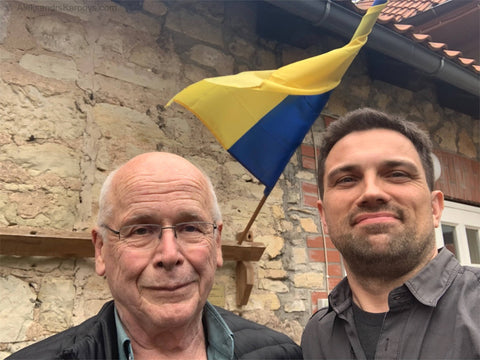

Here's a photo of the grave site on our grandfather’s land, where I buried my brother in 1994.
During the summer of 2023, I went back with my wife Michele, daughter Aleksandra and her son, Keidens to place mom next to my brother. She had died in Minnesota in 1965 at the age of 51. I had her exhumed in October of 2020 but was prevented from returning her by flight restrictions under Covid-19. I finally put her to rest in her native soil on June 12, 2023, her 109th birthday. Lūcija is now at peace between her sister Regina and son Aleksandrs on her father’s land in Latvia.
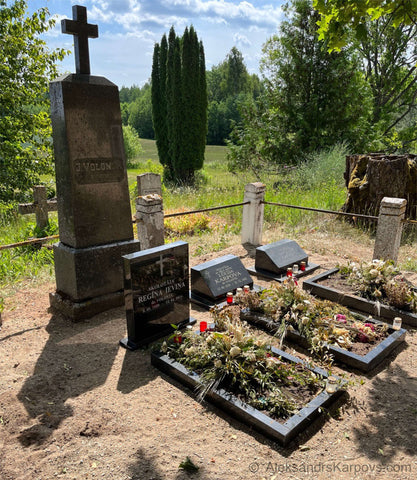

Konstantīns and 6-year-old grandson Keidens place flowers on Lūcija’s grave beside Aleksandrs on June 12, 2023 – Lucija’s 109th birthday!
Examples of Aleksandrs’ art in America:
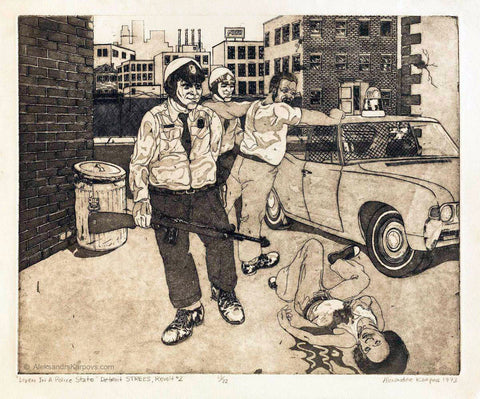
“Livin’ in a Police State, Detroit S.T.R.E.S.S.” Etching 1973
In the 1970s, a racist police vigilante program known as “S.T.R.E.S.S.” (Stop Robberies and Enjoy Safe Streets), terrorized the African American community by killing indiscriminately. They invaded homes or stopped workers on their ways to and from their shifts at the auto plants. If this sounds all too familiar in today's world of George Floyd’s murder and police brutality, it should. Aleksandrs saw this when he made this image to help us remember our past, what he described as “history accuses”. This etching is of an actual event that took place in Detroit in 1972. An Afro-American father and his son were walking home from the movies, when the police stopped them and began shooting, killing the 14-year-old son. The police later stated that they suspected them of being burglars, even though this occurred during the early afternoon and the suspects did not attempt to flee or resist in any way. Aleksandrs described these killings as “... the ultimate in institutionalized racism in America.”
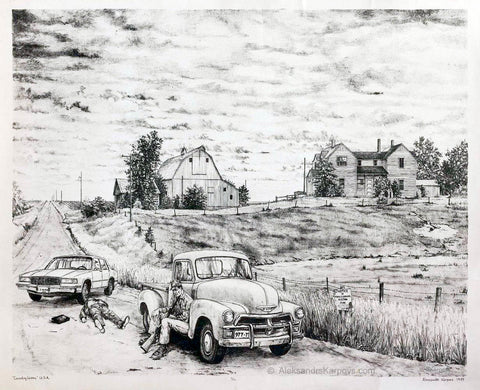
“ Country Livin’” Lithograph 1989
An example of Alexanders' later work in the U.S., is the 1989 lithograph “Country Livin’”. In this print, a farmer in the midwestern United States has already killed a bank agent and prepares to end his own life. Suicides among American farmers were common during the 1980s, often associated with foreclosure as the banks repossessed property. Suicide among people losing their land is commonplace, even to this day. For example, there were 17,500 farmer suicides reported in India in 2002 to 2006.
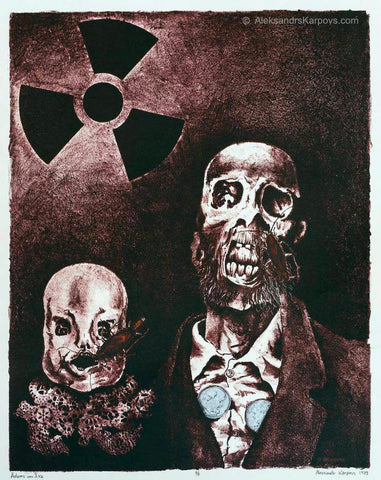
“Adam and Eve” Lithograph 1889
Alexandrs' work was intended to shock the viewer, as in this piece foretelling the potential for nuclear holocaust. His message is simply that if the countries of the world do not eliminate nuclear weapons and nuclear power plants producing nuclear waste, humankind may no longer inhabit this planet. The grotesque, decomposing figures are meant to shock the viewer. The expressions of horror on their faces indicate that their deaths did not come easily. One is a man and the other is an infant. Crawling on their faces are two large cockroaches. The one with an egg sack is “Eve” and the other one is “Adam.” In the upper left is the universal symbol of radiation. On the man's chest are two coins; one a Soviet Russian Ruble depicting Lenin’s bust, and the other an American Kennedy half dollar. The coins symbolize the two greatest culprits who have produced the most nuclear waste and had the largest nuclear arsenals in the world. This situation became frighteningly clear in the 1990s when the Russian government disclosed that it had dumped at least twenty nuclear reactors and an unknown quantity of nuclear waste into the oceans of the world.
“La Dolce Vita (The Sweet Life)” Etching 1990
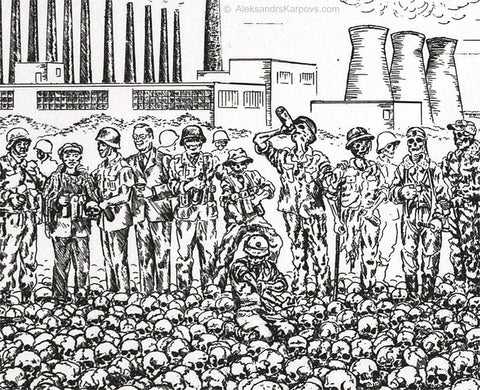
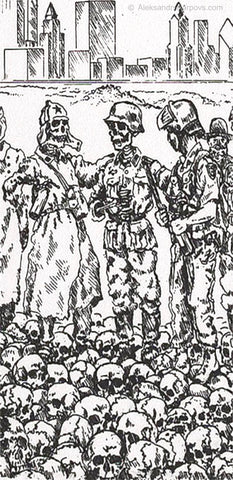

Among the last prints from Alexanders’ work in America is the 1990 "La Dolce Vita (The Sweet Life)." This print combines his distaste for crimes against nature and humanity. Indeed, in “The Sweet Life,” we see the perpetrators of murder and crimes against humanity from various countries including the U.S., atop their harvest of human skulls in killing fields. Some are celebrating under a hanging tree. Soldiers and police of every nation are shown as ‘brothers in arms,’ rejoicing their victory over life. Behind them, our civilization is destroying the life of the planet itself, with pollution and fallout from the nuclear reactor meltdown at Three Mile Island in the U.S.
This work and “Adam and Eve” are prescient; given nuclear weapons proliferation, and nearly identical disasters at Chernobyl and Fukushima, which dwarf the Three Mile Island catastrophe. Add global warming, and the smokestacks fueling our ‘sweet life’ it all becomes more ominous. Alexanders’ message was indeed ahead of his time.
I'm asking for your help to show Aleks’ work throughout America. I will be asking several museums, starting with the University of Minnesota Holocaust Museum. The University of Minnesota, where he was an alumnus, would be a appropriate place to show his art, as would the Holocaust Museum in Washington, DC.
Americans need to be reminded that holocausts and genocides are ongoing. In addition to the Jewish people, we've seen these horrors visited on Native Americans, Rwandans, Cambodians, Ukrainians, Latvians, Armenians, and many many other peoples. It goes on and on. Likewise, Americans need to recognize that again today, “brown fascism”, now in the guise of Trumpism, is an immediate risk to the world and our democracy!
We must be willing to confront our past and learn to face evil among us. So please, follow the Director’s blog in the future! I will describe more of Aleks’ story as time goes on.

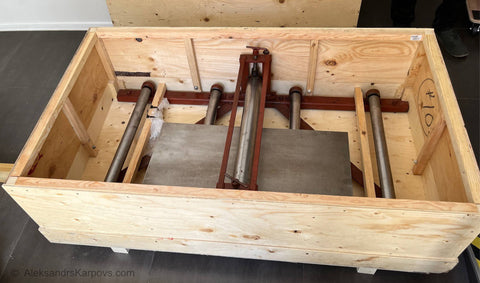
(Aleksandrs' lithographic press as displayed at PLMC with original "Oak 1992" zinc plate. The press is boxed for air shipment to U.S. by volunteer artist Raitis Jelevičs.)
Again, please contact me if you're interested in putting on a collaborative showing, anywhere in the United States now or in the future. All 37 pieces are ready for display, including their matting and framing. I personally will assist in setup, including providing text describing the works. Also available to be included is Aleksandrs’ lithographic press (shown above) which has been shipped from Latvia and can be delivered to your museum for the showing!
Sincerely Konstantīns Karpovs – Director
[1] All of the art and text on this site has copyright © protection from unauthorized duplication by both USA and Latvian copyright law.
----
[2] Ironically, until recently American history had ignored the fact of Stalin's first genocide of Uranian people was in the1930s.—known as the Holodomor, a combination of the Ukrainian words for “starvation” and “to inflict death”—by one estimate claimed the lives of 3.9 million people, about 13 percent of the population. And, unlike other famines in history caused by blight or drought, this was caused when Stalin wanted both to replace Ukraine’s small farms with state-run collectives and punish independence-minded Ukrainians who posed a threat to his totalitarian authority.

1 comment
Testing comment checking on Halloween night at 09:30 PST KAK